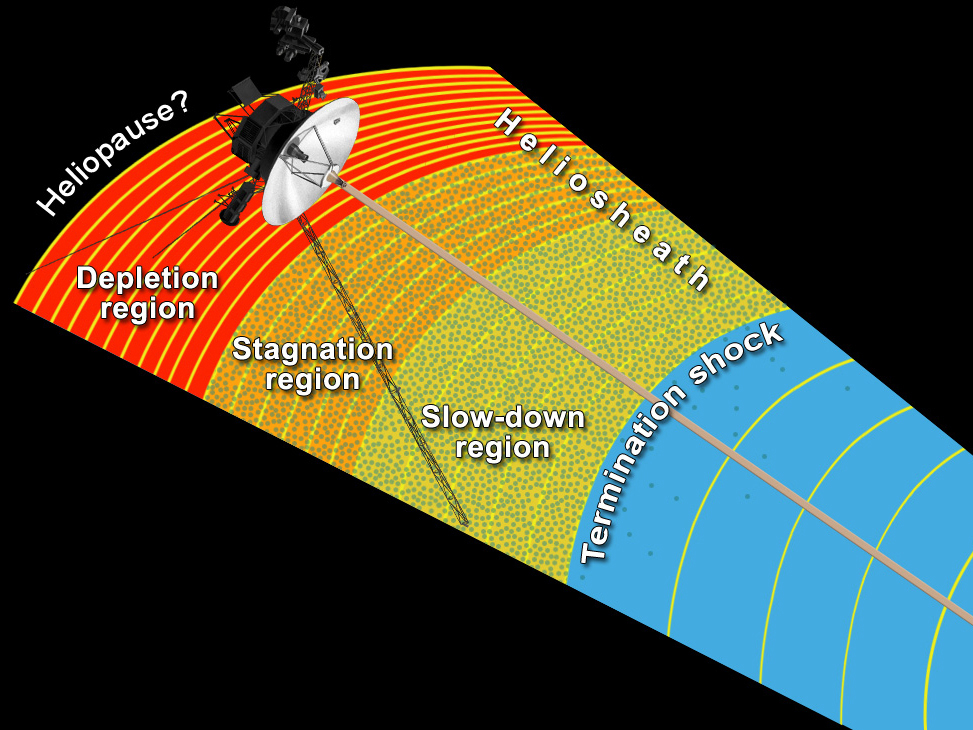In August 2012, Voyager 1 went where no human-made object has gone before: it crossed the “heliopause,” the outermost edge of the Sun’s heliosphere, and entered interstellar space.
Alpha Centauri a and b, two of our nearest neighbouring stars. Image: Wikimedia
Before Voyager 1 left the bubble of territory dominated by the Sun, it collected our very first data on the cold, dark borderlands marking the interstellar boundary. Now, Voyager 2 is making the same journey — passing through the outer layer of our heliosphere, toward all that lies beyond it. But five years later, that journey is shaping up to be remarkably different.
“The [boundary] where Voyager 2 is [leaving the heliosphere] is quite different than for Voyager 1,” Ed Stone, the former director of NASA’s Jet Propulsion Laboratory, said in a presentation at the American Geophysical Union Conference last week. “Which makes comparisons and extrapolations rather uncertain.”
Stone is making those comparisons anyway, uncertainties be damned. Having worked on the Voyager 1 mission since 1972, he knows better than most just how precious and unique this data is. As he explained during his talk, the differences between what Voyager 1 saw, and what Voyager 2 is seeing now as it passes through the outer reaches of the heliosphere, offer an unprecedented glimpse into the structure of this bubble of starstuff we call home.
Let’s talk about that bubble. At its center lies our Sun, which beams out streams of high-energy particles, called the solar wind. As it disseminates into the vacuum of space, the solar wind forms something a bit like a planetary atmosphere, only much larger. This is called the heliosphere.
Like Earth’s atmosphere, the stuff inside the heliosphere is separated from the stuff outside — in this case, an interstellar wind made up of different particles left over from long dead stars — by a magnetic field. Roughly speaking, the Sun’s magnetic field bubbles off a region of space 100 astronomical units wide (1 AU being the distance between Earth and the Sun).

Diagram of the heliosphere, with the rough trajectories of Voyagers 1 and 2. Image: Wikimedia
But the bubble is not air-tight. Interstellar space and the heliosphere interact, mostly, in a vast and poorly-studied region called the “heliosheath.” It’s this region of space that Voyager 2 is now crossing. As Stone explained in his talk and a follow-up interview, the space probe’s recent data offers new insights into what’s happening there.
When Voyager 1, which is headed northward from the solar equator, crossed the heliosheath between 2004 to 2012, it witnessed a steady increase high-energy particles, called galactic cosmic rays (GCRs). But Voyager 2, which is now passing through the heliosheath to the south, isn’t seeing that. “With Voyager 1 that intensity [of GCRs] doubled as we moved through the last stretch,” Stone said. “With Voyager 2, the intensity is very flat in time.”
Stone suspects the discrepancy has to do with the fact that we’re now at a more active phase in the solar cycle. GCRs are interstellar intruders; they cross our borders in greater numbers when the solar wind is weak. That was probably the case when Voyager 1 was making this journey.
“When Voyager 1 was in heliosheath, there was relatively low [solar] activity,” Stone explained. “Voyager 2 is in heliosheath when lots is happening — there’s a lots of stuff coming from sun.” As a result, we’re now learning just how strong of a barrier our bubble can be.
The fact that our Sun is coming down off a solar maximum may help explain another discrepancy. Voyager 2’s data shows that within the heliosheath, the solar wind is getting twisted and diverted “downstream,” forming a long, comet-like tail.

Diagram of the heliosphere created in June 2013 that incorporates findings from Voyager 1. Image: NASA/JPL-Caltech
This is something scientists expected to see, based on our theoretical understanding of what happens when the solar wind bumps into the interstellar wind. But Voyager 1 didn’t register changes in the wind direction. “Voyager 1 was in a stagnation zone,” Stone said. “The wind slowed down, but it didn’t turn. But Voyager 2 is in a different place, and also a different time.”
Voyager 1, at a distance of 137 AU, is headed toward the Ophiuchus constellation in the north, while Voyager 2, 113 AU out from the home star, is speeding toward the Pavo constellation in the south. Stone suspects Voyager 2 will enter interstellar space in a year or two’s time, but nobody’s sure.
“We have an expectation as to when Voyager 2 will cross heliopause, but it’s based on Voyager 1, and we know that where Voyager 2 is is different,” he said.
But Stone doesn’t mind waiting. “We’re learning how stars interact with what’s outside,” he said. “We had ideas and models, now we have data.”
How long will the Voyager probes keep in touch with our pale blue dot? Both spacecraft are powered by the radioactive decay of plutonium-238, which has a half-life of 88 years. The brutal reality is that each year, the spacecraft have less power to work with than they did the year before. “We’ve already turned off a lot of things, and we’ll have to continue turning things off as time goes on,” Stone said.
But if all goes well, we’ve got a few more decades before either probe winks out in the void. Until that day, the Voyager missions will continue teaching us about our cosmic bubble, and the unfathomable vastness that lies beyond.
For now, the journey continues.
